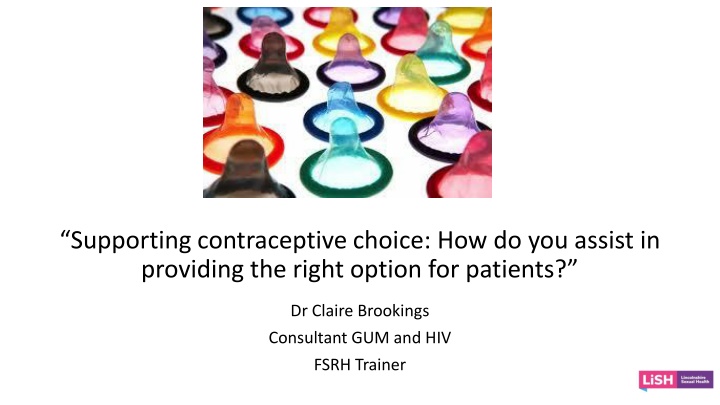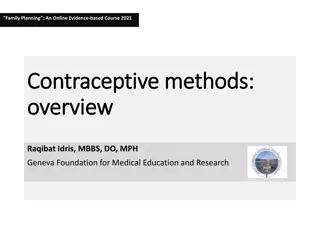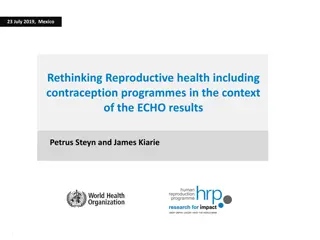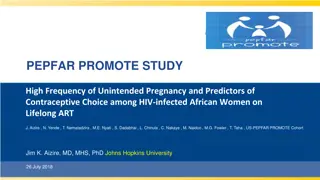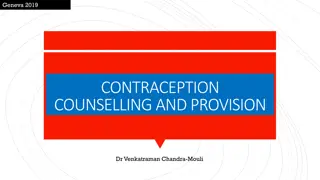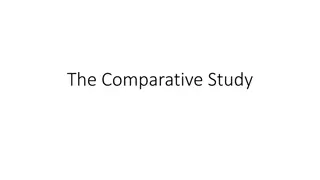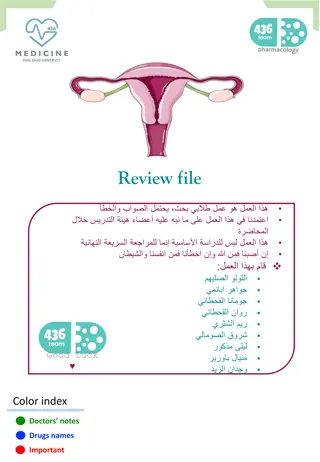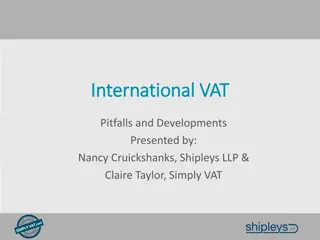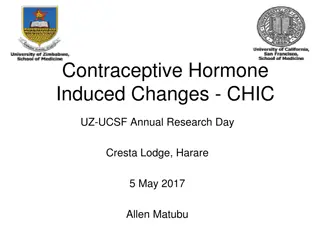Supporting Contraceptive Choice for Patients: Options by Dr. Claire Brookings
Assisting patients in selecting the right contraceptive method is crucial. Dr. Claire Brookings, a leading consultant in GUM and HIV/FSRH training, provides expert guidance on supporting contraceptive choices. Her insights empower healthcare professionals to offer comprehensive information and personalized recommendations tailored to patients' needs and preferences, ensuring informed decision-making and effective contraception management.
Download Presentation

Please find below an Image/Link to download the presentation.
The content on the website is provided AS IS for your information and personal use only. It may not be sold, licensed, or shared on other websites without obtaining consent from the author.If you encounter any issues during the download, it is possible that the publisher has removed the file from their server.
You are allowed to download the files provided on this website for personal or commercial use, subject to the condition that they are used lawfully. All files are the property of their respective owners.
The content on the website is provided AS IS for your information and personal use only. It may not be sold, licensed, or shared on other websites without obtaining consent from the author.
E N D
Presentation Transcript
Supporting contraceptive choice: How do you assist in providing the right option for patients? Dr Claire Brookings Consultant GUM and HIV FSRH Trainer
Patients choice Patient s previous experience Patient s previous Hx Patient s knowledge/understanding fears and concerns Supporting Contraceptive Choice
Mode of Action Efficacy What to start Regimes Missed pills Side Effects Risks/red flags Benefits COC not just pills COC
COC Mode and Efficacy Suppresses LH and FSH thus inhibits ovulation Progestogen exposure Thinning endometrium Cervical plug Efficacy 9% pregnancy risk in first year 0.3% pregnancy risk in first year if perfect use
What to start? Ethinylestradiol 30mcg/ levonorgestrel Ethinylestradiol 30mcg / norethisterone ef8ba906a03e7080-f2801769e605-Choosing-a-combined-oral- contraceptive-pill.pdf (nps.org.au)
Cocp Oestrogenic Norgestimate Desogestrel Gestodene Progestogenic Norethisterone Levonorgestrel Drosperidone ( anti- androgenic/anti mineralcorticoid)
Regimes 21/7 21/4 Tri-cyclying Tailored use Continuous use
Missed Pills What should I do if I miss a pill (combined pill)? - NHS (www.nhs.uk) Missed one pill Continue pills- take one pill asap then continue at normal time Can take 2 pills in a day Missed 2-7 pills Week 1 Consider EC /Continue pills/Condoms 7 days Week 2 Continue pills Week 3 Continue pills Continue next pack Missed >7 pills Consider EC
COC Side Effects Headache Can resolve with time HFI- continuous/extended use Migraine Break through bleeding Often can resolve More common with low dose oestrogen Consider switching type of COCP Check compliance Check DDI Advise check for STI/ medical review
COC Side Effects Mood Some women do experience a negative effect on mood No clear consistent evidence Consider changing formulation to alternative progestogen If premenstrual, consider continuous use Weight gain No evidence Libido No evidence
COC Side Effects Nausea Take at night Reduce oestrogen Bloating Reduce oestrogen Drospirenone Breast tenderness Reduce oestrogen Drospirenone
PGD exclusions Individuals under 16 years of age and assessed as not competent using Fraser Guidelines. Individuals 16 years of age and over and assessed as lacking capacity to consent. Established pregnancy. Note risk of pregnancy with a negative pregnancy test is not an exclusion. Known hypersensitivity to the active ingredient or to any constituent of the product - see Summary of Product Characteristics (SPC). Individuals aged 50 years and over. Significant or prolonged immobility. Individuals who have had a gap (of any duration in length) in their COC cycle. Cardiovascular disease Individuals aged 35 years and over that smoke or stopped smoking less than one year ago (this includes vaping and the use of e-cigarettes). Body Mass Index (BMI) equal to or greater than 35kg/m2. Blood pressure greater than 140/90mmHg or controlled hypertension. Multiple risk factors for cardiovascular disease (CVD) (such as smoking (including vaping/use of e-cigarettes), diabetes, hypertension, obesity, and dyslipidaemias). Current or past history of ischaemic heart disease, vascular disease, stroke, or transient ischaemic attack. Current or past history of venous thromboembolism. 6 Complicated valvular or congenital heart disease, e.g., pulmonary hypertension, history of subacute bacterial endocarditis. First degree relative (a person's parent, sibling, or child) with venous thromboembolism which first occurred when they were under 45 years of age. Known thrombogenic mutations, e.g., factor V Leiden, prothrombin mutation, protein S, protein C and antithrombin deficiencies. Cardiomyopathy with impaired cardiac function. Atrial fibrillation. Neurological Conditions Current or past history of migraine with neurological symptoms including aura at any age. Migraine without aura, first attack when on method of contraception containing an estrogen. Cancers Past or current history of breast cancer. Carrier of known gene mutations associated with breast cancer, e.g., BRCA1or 2. Malignant liver tumour (hepatocellular carcinoma). Gastro-intestinal Conditions Severe (decompensated) cirrhosis. Gall bladder disease, currently symptomatic or medically managed. Any bariatric or other surgery resulting in malabsorption. Cholestasis (related to past combined hormonal contraceptive use). Benign liver tumour (hepatocellular adenoma). Other conditions Imminent planned major surgery (COC should be stopped at least 4 weeks prior to planned major surgery or expected period of limited mobility). Diabetes with end organ disease (retinopathy, nephropathy, neuropathy). Positive anti-phospholipid antibodies (with or without systemic lupus erythematosus). Organ transplant, with complications. Known severe renal impairment or acute renal failure. 7 Acute porphyria. Medicines Individuals using enzyme-inducing drugs/herbal products or within 4 weeks of stopping them. Interacting medicines (other than enzyme inducers) including any medicines or herbal products purchased see current British National Formulary (BNF) www.bnf.org or individual product SPC http://www.medicines.org.uk
COC- Risk VTE MI CVA Breast CA Cervical Ca Other PGD exclusions
COC- benefits Heavy Menstrual bleeding Menstrual pain Acne Premenstrual symptoms Endometriosis PCOS Endometrial Ca Ovarian Ca
COC patch Exchange patch weekly 3/52 1/52 break
COC- vaginal ring 3/52 use then remove Reinsert after 1/52
Types Mode of action Efficacy SE Risks Missed pills D and V POP
Types Desogrestrel 75mcg Norethisterone 350mcg Levonorgestrel 30mcg
Mode of Action and Efficacy General effects on the viscosity of cervical mucus Thins the endometrium Reduces activity of cilia in the fallopian tube Desogestrel Inhibits ovulation The risk of pregnancy during the first year of typical POP use has been estimated at about 9% . If used perfectly POPs may be more than 99% effective
Side Effects POP bleeding Desogestrel 4 in 10 have normal frequency bleeding 2 3 in 10 are amenorrhoeic 3 in 10 have infrequent bleeding Fewer than 1 in 10 have frequent bleeding 1 in 10 have prolonged bleeding Traditional POP 8 in 10 have normal bleeding Less than 1 in 10 are amenorrhoeic 1 in 10 have infrequent bleeding 1 in 10 have frequent bleeding Less than 1 in 10 have prolonged bleeding
Side Effects - POP Changes in mood/libido Weight change Acne Headache No hard evidence
Risks Individuals under 16 years of age and assessed as not competent using Fraser Guidelines. Individuals 16 years of age and over and assessed as lacking capacity to consent. Established pregnancy. Note risk of pregnancy with a negative pregnancy test is not an exclusion. Known hypersensitivity to the active ingredient or to any constituent of the product - see Summary of Product Characteristics (SPC). Acute porphyria. Individuals aged 55 years and over. Individuals who have had a gap (of any duration in length) in their POP cycle. Cardiovascular Disease Current or past history of ischemic heart disease, vascular disease, stroke, or transient ischemic attack (first attack only) if taking the method when the event occurred. Cancers Current or past history of breast cancer. Malignant liver tumour (hepatocellular carcinoma). Gastro-intestinal conditions Severe (decompensated) cirrhosis. Benign liver tumour (hepatocellular adenoma). Any bariatric or other surgery resulting in malabsorption. 6 Medicines Individuals using enzyme-inducing drugs/herbal products or within 4 weeks of stopping them. Individuals taking any interacting medicines (other than enzyme inducers) including medicines or herbal products purchased see, current British National Formulary (BNF) www.bnf.org or individual product SPC http://www.medicines.org.uk.
Risks - Progesterone and Breast Ca To consult with pts Similar to CHC Shown with all PO contraception Small increase in risk, but overall risk low and not long lasting
Benefits Dysmenorrhea May cause amenorrhea Can be used in some pts when oestrogen is CI
Missed Pills and D&V Desogestrel >12 hours Vomiting before 3-4 hours Traditional POP >3 hours Vomiting before 2 hours Diarrhoea caution re absorption during and until 48 hours
Types Mode of action Benefits S/E Risks EC IUD
IUD types High Dose hormonal coil 52mg IUD Low Dose hormonal coil 19.5mg IUD or 13.5 mg IUD Cu Coil Cu IUD
LNG-IUS Main effect pre fertilisation Cervical mucus plug Thins the endometrium >75% still ovulate Hormonal levels similar to oral POP Side effects Breast Ca risk
LNG-IUS- high dose 52mg levonorgestrel 6 years Extended use Can be used 5 years as progesterone component for HRT
LNG-IUS low dose Smaller and easier to insert 3-5 years device dependent Useful for pts concerned about hormones
Copper IUD 5-10 years 380mm2 copper Extended use 0.8% failure rate ( 0.6%) Toxic to egg and sperm Irritates endometrium Used as EC Side Effects
Copper- IUD EC Up to 120 hours post UPSI Up to Day 5 after earliest likely ovulation
IUD - risks Procedural risks Ectopic pregnancy Infections Expulsion
Barrier methods Types
Condoms Caya diaphragm 2 hours / 6 hours
Exclusions are exclusion Young people Length of prescription Working off PGD
Exclusions are exclusions Explain limitations of service Explain that a prescriber will be able to fully assess and advise Signpost GP LISH 01522 309309 Advise regarding alternative forms of contraception
Frazier Competence the young person cannot be persuaded to inform their parents or carers that they are seeking this advice or treatment (or to allow the practitioner to inform their parents or carers) the young person understands the advice being given the young person's physical or mental health or both are likely to suffer unless they receive the advice or treatment it is in the young person's best interests to receive the advice, treatment or both without their parents' or carers' consent the young person is very likely to continue having sex with or without contraceptive treatment
Length of Prescription 3/12 to start 6/12 at first review 12/12 if stable
Drugs and Contraception
Cu-IUD Hormonal IUD DMPA Enzyme Inducers
Cu- IUD Hormonal- IUD Implant DMPA with condoms CHC with condoms POP with condoms Teratogenic medications
Teratogenic and enzyme inducers Cu-IUD Hormonal-IUD DMPA with condoms
Lamotrigine Lamotrigine The effect of lamotrigine on contraception May make it less effective All CHC, POP and Implant advise 100% condom use The effect of contraception on lamotrigine Oestrogen can lower Lamotrigine levels causing fits Progesterone can increase levels causing toxicity
Lamotrigine Lamotrigine COCP Avoid Monitor levels Avoid HFI If staring/stopping liaise with GP/neurology Advise condom use POP Advise to be vigilant re toxicity symptoms ( dizziness, ataxia,diplopia) Consider monitoring levels If starting/stooping liaise with GP/neurology Advise condom use apart from DMPA
Topiramate Topiramate Enzyme inducing effect at higher doses Teratogenic For any dose due to wide inter-individual variability of metabolism CU-IUD Hormonal- IUD DMPA with condoms
